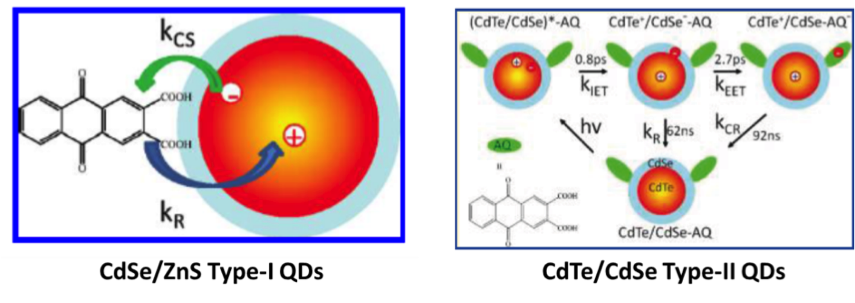Exciton Dynamic in Low-Dimention Materials
Low-dimensional semiconductor nanomaterials, in particular, 0D quantum dots, 1D nanorods, 2D nanosheets, and their heterostructures, have been widely investigated as light harvesting and charge separation components in photovoltaic and photocatalytic devices for solar energy conversion due to their novel properties of tunable light harvesting and emission, large cross-section, and charge separation. Herein, it is important to understand and engineer those exciton dynamics (charge separation and recombination), which determines the overall efficiency.
In our group, we are focusing on the charge dynamics in cadmium chalcogenide (CdX, X = Se, S, Te) colloidal low-dimensional nanomaterials and their heterostructures:
0D quantum dots:
(i)Wavefunction engineering for tunable charge seperation and recombination in Type-I (CdSe/ZnS), Type-II (CdTe/CdS) core/shell quantum dots
Quantum dots (QD) have emerged as a new class of light harvesting and charge separation materials for solar energy conversion. Because of quantum confinement effect, the excitonic transitions in QDs can be widely tuned by their size. Such size dependent energetics provides an ideal platform for testing ET models in excitonic nanomaterials. By tunning the size of the core and the thickness of the shell, we are able to control the charge seperation and recombination rate from QDs to attached molecules or catalysts.
(ii)Multi-exciton dissociation in CdSe/CdS quasi-Type-II quantum dots
The photogenerated excitons in CdSe/CdS quasi-type II quantum dots enables ultrafast charge separation and ultraslow charge recombination. Up to nineteen excitons per QD can be generated by absorbing multiple 400 nm photons and all excitons can be dissociated with unity yield by electron transfer to adsorbed methylviologen molecules, demonstrating that quasi-type II QDs can be engineered to efficiently dissociate multiple excitons and deliver multiple electrons to acceptors, suggesting their potential applications as light harvesting and charge separation components in artificial photosynthetic devices.
(iii)Auger-assisted Electron Transfer from Photoexcited Semicondcutor Quantum Dots
The rate of photoinduced electron transfer from QDs (CdS, CdSe, and CdTe) to molecular acceptors (anthraquinone, methylviologen, and methylene blue) increases at decreasing QD size (and increasing driving force), showing a lack of Marcus inverted regime behavior over an apparent driving force range of ∼0−1.3 V. We account for this unusual driving force dependence by proposing an Auger-assisted electron transfer model in which the transfer of the electron can be coupled to the excitation of the hole, circumventing the unfavorable Franck−Condon overlap in the Marcus inverted regime.
1D nanorods:
(i)Semiconductor-metal heterostructures for efficient charge separation
NRs can simultaneously exhibit quantum confinement effects in the radial direction and bulk like carrier transport in the axial direction. The former implies that concepts well-established in zero-dimensional quantum dots, such as sizetunable energetics and wave function engineering through band alignment in heterostructures, can also be applied to NRs; while the latter endows NRs with fast carrier transport to achieve long distance charge separation. Selective growth of catalytic metallic nanoparticles, such as Pt, at the tips of NRs provides convenient routes to multicomponent heterostructures with photocatalytic capabilities and controllable charge separation distances. The design and optimization of such materials for efficient solar-tofuel conversion require the understanding of exciton and charge carrier dynamics.
(ii)Plasmon-Induced Charge Separation and Photochemistry in Colloidal Semiconductor-Metal Nanoheterostructures
We focus on the plasmon-induced hot electron transfer from metal to semiconductor: photovoltaics, photocatalysis and photodetection. Mechanism studies into the charge separation and recombination rates and quantum yields are needed. This nanoheterostructures has Strong electronic coupling due to direct attachment, efficient separation due
2D nanosheets:
(i)Ultrafast exciton diffusion and quenching pathways in CdSe nanosheets (NSs) and CdSe nanosheet-Pt heterostructures
2D nanosheets have better quantum confinement for faster in-plane charge transport, larger surface area for efficient charge separation, and higher photoluminescence quantum yield compared to 0D and 1D nanomaterials, which make them better absorbing materials for solar energy conversion. Ultrafast exciton diffusion was studied in CdSe NS-Pt heterostrucuture and the exciton can be quenched by either energy transfer to Pt or charge dissociation.
(ii)Engineered exciton dynamics in core-crown type-I (CdSe/CdS) and type-II (CdSe/CdTe) nanosheets heterostructures
 Exciton dissociation pathway can be engineered by lateral extension from 2D nanosheets (NSs) core to core-crown (CC) heterostructure. In Type-I CdSe/CdS CC NSs, the photoexcited excitons are all localized to CdSe core and the interface of core and crown and emit at CdSe according to type-I band alignment, which make it an efficient exciton concentrator. In type-II CdSe/CdTe CC NSs, the exciton can dissociate with electron on CB of CdSe and hole on VB of CdTe at the interface in a unity dissociation yield. We focus on the exciton localization and dissociation efficiency and the charge transfer rate and mechanisms.
Exciton dissociation pathway can be engineered by lateral extension from 2D nanosheets (NSs) core to core-crown (CC) heterostructure. In Type-I CdSe/CdS CC NSs, the photoexcited excitons are all localized to CdSe core and the interface of core and crown and emit at CdSe according to type-I band alignment, which make it an efficient exciton concentrator. In type-II CdSe/CdTe CC NSs, the exciton can dissociate with electron on CB of CdSe and hole on VB of CdTe at the interface in a unity dissociation yield. We focus on the exciton localization and dissociation efficiency and the charge transfer rate and mechanisms.

